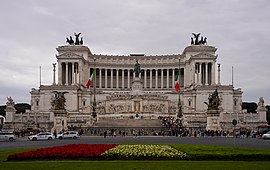
Back النصب التذكاري لفيتوريو إمانويلي الثاني Arabic Вітарыяна Byelorussian Национален паметник на Виктор Емануил II (Рим) Bulgarian Altare della Patria Breton Monument nacional a Víctor Manuel II Catalan Altare della Patria Czech Victor Emanuel-monumentet Danish Nationaldenkmal Viktor Emanuels II. German Εθνικό Μνημείο του Βιτόριο Εμανουέλε Β΄ Greek Vittoriano Esperanto
| Victor Emmanuel II National Monument | |
|---|---|
Monumento Nazionale a Vittorio Emanuele II | |
 View from Piazza Venezia | |
 Click on the map for a fullscreen view | |
| Alternative names | "Mole del Vittoriano" "Il Vittoriano" "Altare della Patria" |
| General information | |
| Type | National monument |
| Architectural style | Neoclassical with eclectic influences |
| Location | Rome, Italy |
| Address | Piazza Venezia |
| Coordinates | 41°53′41″N 12°28′59″E / 41.89472°N 12.48306°E |
| Construction started | 1885 |
| Completed | 1935 |
| Inaugurated | 4 June 1911 |
| Owner | Ministry of Cultural Heritage and Activities |
| Height | 81 m (266 ft) |
| Dimensions | |
| Other dimensions | 135 m (443 ft) across x 130 m (427 ft) deep |
| Technical details | |
| Floor area | 717,000 m2 (7,717,724 sq ft) |
| Lifts/elevators | 1 |
| Grounds | 1.755 ha (4.34 acres) |
| Design and construction | |
| Architect(s) | Giuseppe Sacconi[1] |
The Victor Emmanuel II National Monument (Italian: Monumento Nazionale a Vittorio Emanuele II), also known as the Vittoriano or Altare della Patria ("Altar of the Fatherland"), is a large national monument built between 1885 and 1935 to honour Victor Emmanuel II, the first king of a unified Italy, in Rome, Italy.[2] It occupies a site between the Piazza Venezia and the Capitoline Hill. The monument was realized by Giuseppe Sacconi.
From an architectural perspective, it was conceived as a modern forum, an agora on three levels connected by stairways and dominated by a portico characterized by a colonnade. The complex process of national unity and liberation from foreign domination carried out by King Victor Emmanuel II of Savoy, to whom the monument is dedicated, has a great symbolic and representative value, being architecturally and artistically centred on the Italian unification—for this reason the Vittoriano is considered one of the national symbols of Italy.
It also preserves the Altar of the Fatherland (Italian: Altare della Patria), first an altar of the goddess Roma, then also a shrine of the Italian Unknown Soldier, thus adopting the function of a secular temple consecrated to Italy. Because of its great representative value, the entire Vittoriano is often called the Altare della Patria, although the latter constitutes only a part of the monument.
It is currently managed by the Polo Museale del Lazio and is owned by the Ministry of Cultural Heritage and Activities.
- ^ Cite error: The named reference
treccanivittorianowas invoked but never defined (see the help page). - ^ Atkinson, David; Cosgrove, Denis (March 1998). "Urban Rhetoric and Embodied Identities: City, Nation, and Empire at the Vittorio Emanuele II Monument in Rome, 1870–1945". Annals of the Association of American Geographers. 88 (1): 28–49. doi:10.1111/1467-8306.00083.
© MMXXIII Rich X Search. We shall prevail. All rights reserved. Rich X Search